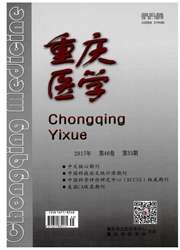

 中文摘要:
中文摘要:
目的探索白血病骨髓基质细胞黏附对HL-60细胞的耐药效应及可能机制。方法分离、培养骨髓基质细胞,然后与HL-60细胞共培养,分为白血病基质组、正常骨髓基质组和HL-60细胞悬浮培养组,分别加入基质细胞条件培养液或用血管内皮细胞黏附分子-1(VCAM-1)抗体或纤维连接素(Fn)抗体预处理骨髓基质层,去甲氧基柔红霉素(IDA)作用24h,MTT法检测HL-60细胞活力,流式细胞仪检测HL-60细胞周期。结果白血病骨髓基质组、正常骨髓基质组HL-60细胞活力明显高于悬浮培养组,白血病骨髓基质组高于正常骨髓基质组;与骨髓基质细胞共培养后,HL-60细胞G0/GI期比例增高,白血病骨髓基质组与正常骨髓基质组间无显著性差异;VCAM-1、Fn单抗处理骨髓基质层后,HL-60细胞活力下降,而基质细胞条件培养液却无影响。结论白血病骨髓基质细胞黏附能促进HL-60细胞耐药,直接的细胞接触可能是其启动条件,部分通过诱导HL-60细胞出现G0/G1期阻滞。
 英文摘要:
英文摘要:
Objective To investigate the effects of leukemic marrow stroma cell(MSC) adhension on the drug resistance of HL - 60 cells and its possible mechanism. Methods MSCs were isolated and cultured and then were co - cultured with HL - 60 cells, which were divided into leukemic ground substance group, normal bone marrow substance group, and HL - 60 cell suspension culturing group. The stroma cell conditioned medium was added or vascular endothelial cell adhesion molecule - 1 ( VCAM - 1 ) antibody or fibronectin(Fn) antibody was used to pretreat the bone marrow hypothallus, respectively. Those cells were exposed under idarubicin (IDA)for 24 h. The viability of HL - 60 cells was detected through MTT method. The HL - 60 cell cycle was detected by flow cytometry. Results The viability of HL - 60 cells in the leukemic ground substance group and normal bone marrow substance group was significantly higher than that in the suspension culturing group, and that in the leukemic group was higher than that in the normal substance group. After the co - culture with marrow stroma cells, the percentage of GO/G1 phase of HL - 60 cells increased, and there was no significant difference between the leukemic ground substance group and the normal bone marrow substance group. After the treatment of bone marrow hypothallus by VCAM - 1 and Fn antibodies, the viability of HL - 60 cells decreased, but it was not affected by the stroma cell conditioned medium. Conclusion The adhesion of leukemic MSCs can promote the drug resistance of HL - 60 cells. Direct cell contact between MSCs and leukemic cells is probably the trigger, which was partially realized through the induction of cell cycle arrest in the G0/G1 phase.
 同期刊论文项目
同期刊论文项目
 同项目期刊论文
同项目期刊论文
 Role of antithymocyte globulin and granulocyte-colony stimulating factor-mobilized bone marrow in al
Role of antithymocyte globulin and granulocyte-colony stimulating factor-mobilized bone marrow in al 期刊信息
期刊信息
